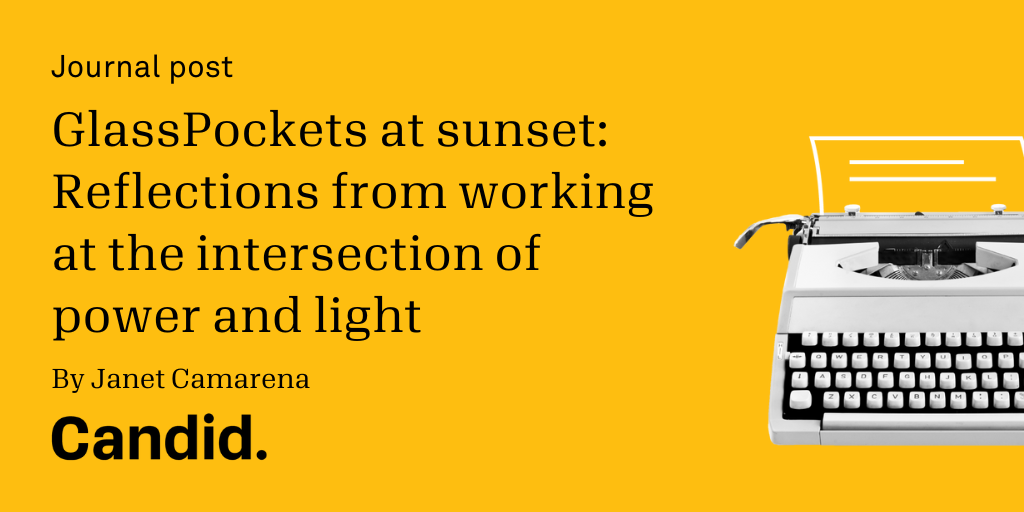The Need – and Appetite for – Enhanced Foundation Transparency
(Rick Cohen is the National Correspondent for Nonprofit Quarterly (NPQ) and the editor of NPQ's Cohen Report. Prior to joining NPQ, Rick was executive director of the National Committee for Responsive Philanthropy, vice president of the Local Initiatives Support Corporation, and vice president of the Enterprise Foundation. A version of this blog appeared in NPQ.)
It is nearly impossible to think about transparency in the world of philanthropy without putting philanthropy into a societal context. Philanthropy is not a world unto itself, but one that is engaged in extensive interactions with other sectors of the economy and society, particularly important in an era of increasingly crippled institutions and practices of democracy in the U.S.
The political context concerns the flows of secret moneys into the electoral process, obviously an activity prohibited to private and public foundations, but one that increasingly shapes the perspectives of the American public toward nonprofits—and, if they knew what foundations were beyond the television portrayals of philanthropoids as white glove socialites—foundations too. Secret money is the lifeblood of American political campaigns, perhaps brought to a level of self-parody when comedian Stephen Colbert points out that Karl Rove is giving anonymous political money to help keep political giving anonymous. The calls for breaking through the wall of secrecy in political spending are increasing, notably in the District and Appeals Court decisions in Van Hollen v. Federal Election Commission.
And so it is with foundations and the calls philanthropic leaders face for increased transparency. As Vikki Spruill, the new leader of the Council on Foundations, noted in what appears to be one of her first official communications to the Council’s membership, institutional philanthropy faces “its most critical moment…right now. At a time when our world faces a storm of converging challenges with dwindling resources, philanthropy’s positive impact remains a mystery to far too many…[W]e must seize the imperative to help society better understand philanthropy’s impact and contributions.”
It is a frequent refrain from foundation leaders, the admonition that foundations have to do a better job at telling their story. But that isn’t transparency. At best, it is managed transparency, telling the story that foundations want public policy decision-makers, the general public, and their specific stakeholders to hear and understand. Transparency, however, is not managed through public relations firms. Can you imagine if the Federal Elections Commission were only to make available the information it thought would tell the story of its “positive impact?” For as miserable and partisanly hamstrung as the FEC is today, the story telling wouldn’t be worth the physical effort of a computer click on “download.”
Transparency empowers the users, the recipients of information, to hold powerful agencies of government, well-heeled donors to political campaigns, and institutions without direct levers of official accountability to the public somewhat more accountable. When you stage manage transparency, it simply isn’t. Of course that doesn’t mean simply opening the doors of foundations and inviting the public to rifle through file cabinets, but it does mean trying to find ways of making essential information more accessible and reviewable by outsiders.
How Public Should Private Philanthropy Be?
In the foundation world, the debate du jour is how public private philanthropy is, that is, to what extent the tax exempt dollars of private foundations should be considered in some ways open to public scrutiny. It is an argument that ultimately boxes everyone into a corner. The philanthropic impulse occurs with a donor willing to put some of his or her excess capital to work for what is hoped to contribute to the public good. But in this nation, that occurs with the benefit of the charitable deduction, applicable to the small scale donations of this nation’s generous working people and to the much larger donations of affluent people who create foundations.
OK, so the funds aren’t quite public dollars—aggrieved constituents cannot ask foundations for administrative redress, they cannot vote foundation trustees out of office, and in all but an incredibility limited number of cases do they even find themselves with standing to litigate a foundation’s grant decisions. And they aren’t quite fully private dollars, else they would be taxed and their managers wouldn’t be filing 990PFs, following IRC rules for executive compensation and self-dealing, or fretting whether President Obama’s annual call for capping itemized deductions including the charitable deduction will depress charitable giving and philanthropic grantmaking.
The Dichotomous Nature of Foundations
Even in their quasi-public identities, foundations have feet planted in two worlds or two cultures, one the private world of a donor, the other a public world of resources afforded a special status by the American public and its elected representatives. It shows in foundations’ postures toward transparency.
In recent history, the advent of the 990 is one example. Commissions on the future shape and substance of philanthropy have all included encomiums of one sort or another in favor of increased transparency, but statements and actions can sometimes differ. Prior to enactment of the Taxpayer Bill, many foundation leaders were opposed to the liberalization of public access to 990s, and when the law was passed, foundation leaders attempted to find ways of divorcing 990PFs from the public access the law required to nonprofits’ 990s and then worked to delay the applicability of the law to foundations.
In practice, a similar dichotomous identity occurs, best exemplified by the foundations’ crisis response to the California legislation that would have required a handful of large foundations to simply report on their grantmaking to nonprofits headed by people of color, not make more grants for communities of color, and report on their own staff and board demographics. Foundations fought the bill, known popularly as AB624, tooth and nail, though many of the same foundations are strong supporters of the racial disclosures required of banks in the Home Mortgage Disclosure Act, have supported nonprofits demanding similar disclosures of utility companies in front of the state’s Public Utilities Commission, and fought strenuously against California’s Proposition 54 initiative which would have generally banned the state from collecting race and ethnicity data.
Another dimension of foundations’ split thinking on transparency is in their relationship with “stakeholders.” This is more than just a fancied up description of grant recipients whose opinions on how well they are treated by foundation program officers are now solicited de rigeur. Stakeholders are different than insiders such as donors, board members, and staff. The Denver Foundation describes “external stakeholders” as “people who are impacted by your work as clients/constituents, community partners, and others.” Lauren Tulp of the Gordon and Betty Moore Foundation suggested grantees, community residents, and external experts as potential stakeholders. In some foundation examples, stakeholders have been recruited to participate in foundation grantmaking processes, including the Bill and Melinda Gates Foundation and some of the health conversion foundations.
This is now common parlance in the foundation world. Stakeholders with a “vested interest” in the foundation’s work merit inclusion in efforts to assess what the foundation is and should be delivering for various communities with what impact. The concept of stakeholders is common in foundation circles—except when it comes to discussions of transparency, when the circle for inclusion becomes distinctly narrower. Foundations have to come to grips with whether the notion of stakeholders is real or simply a rhetorical device meant to convey a transitory sense of inclusivity.
--Rick Cohen
This post is the first of a two-part series by Rick Cohen. Part two follows on Wednesday, August 22.


